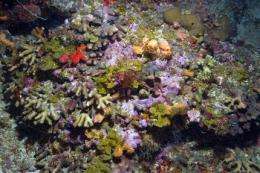In this undated photo provided by Richard Appeldoorn, a professor at the University of Puerto Rico in Mayaguez, is seen newly discovered coral off the coast of Puerto Rico. Reefs located at a depth of up to 500 feet (152 meters) within a 12-mile (19-kilometer) area were recently discovered as part of a federally funded mission to conduct research on deep-water corals according to the U.S. National Oceanic and Atmospheric Administration. (AP Photo/Hector Ruiz)
(AP) -- As the ocean floor plunges off southwestern Puerto Rico, it reveals coral reefs dotted with bright-blue sea squirts and a multitude of other organisms whose existence has given hope to scientists who strive to save the island's threatened ecosystems.
The organisms are an integral part of a group of reefs discovered to be thriving near an area where most shallow coral reefs and the fish that depend on them are in poor health overall.
The reefs - at a depth of up to 500 feet (152 meters) in an area 12 miles (19 kilometers) across - were recently discovered as part of a federally funded mission to conduct research on deep-water corals, according to the U.S. National Oceanic and Atmospheric Administration.
"We stumbled across this area," Richard Appeldoorn, a professor at the University of Puerto Rico in Mayaguez who was involved in the mission, told The Associated Press on Thursday.
Divers enrolled in a one-year training course to depths of up to 100 feet (31 meters) noticed the thriving reefs and large predators lurking nearby, said Appeldoorn, who oversees the university's fisheries, biology and coral reef studies program.
The deep underwater landscape they encountered was populated by lettuce coral, the lace-like star coral and several species of sponges, as well as groupers, snappers and reef sharks, said Appledoorn, who is calling for the protection of the reefs and nearby shallower areas where fish spawn and later retreat to deeper waters.
"Any large fish is always neat to see, not having seen them on top of the (ocean) platform for decades, or not at all," he said.
The reef's existence means that struggling, shallow ecosystems in the U.S. Caribbean territory may have a better-than-believed chance at survival, because fish species thriving at a deeper level can help replenish stocks in more shallow reefs, said Appeldoorn and Ernesto Diaz, director of Puerto Rico's Coastal Zone Management Program.
"It's a pleasant surprise to know that species you thought you wouldn't see again exist," Diaz said.
The discovery - first announced by NOAA last week - comes as officials in Puerto Rico and the U.S. Virgin Islands seek to create the Caribbean Regional Ocean Partnership, an endeavor that aims to better coordinate the use of coastal waters and the implementation of conservation programs.
The two islands recently submitted a proposal for the partnership to NOAA, which also financed the mission that led to the discovery of the new reefs.
Among the partnership's proposed goals is the creation of a zoning map for waters surrounding Puerto Rico and the U.S. Virgin Islands. The map would designate certain areas for conservation, recreation or commercial purposes, Diaz said.
The project also would allow researchers to explore how the ocean could be harnessed for energy or for the development of fish farms or the installation of underwater fiber-optic cables, Diaz said.
Officials decided to launch the project shortly after the administration of President Barack Obama approved a recent new policy that strengthens the way the U.S. manages its oceans and coasts.
"About 22 percent of Puerto Rico's waters are protected," Diaz said. "The other 78 percent, what potential do they have?"
Diaz said the partnership would eventually extend to the nearby Dominican Republic and the British Virgin Islands.
As Diaz awaits approval from NOAA, scientists including Appeldoorn are beginning to explore reefs off the nearby island of Mona, which is just west of Puerto Rico and is sometimes the unintended final destination of migrants from Cuba and the Dominican Republic.
©2010 The Associated Press. All rights reserved. This material may not be published, broadcast, rewritten or redistributed.




















